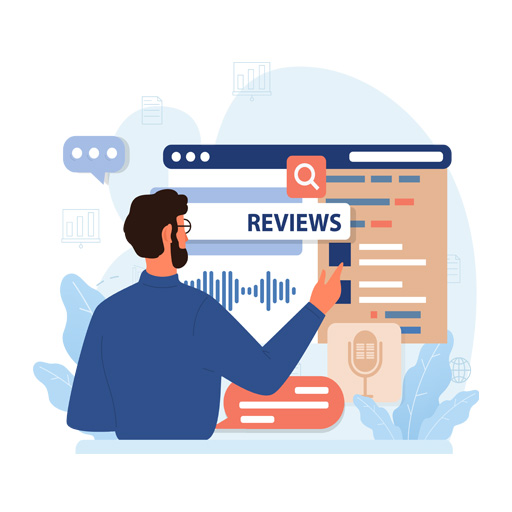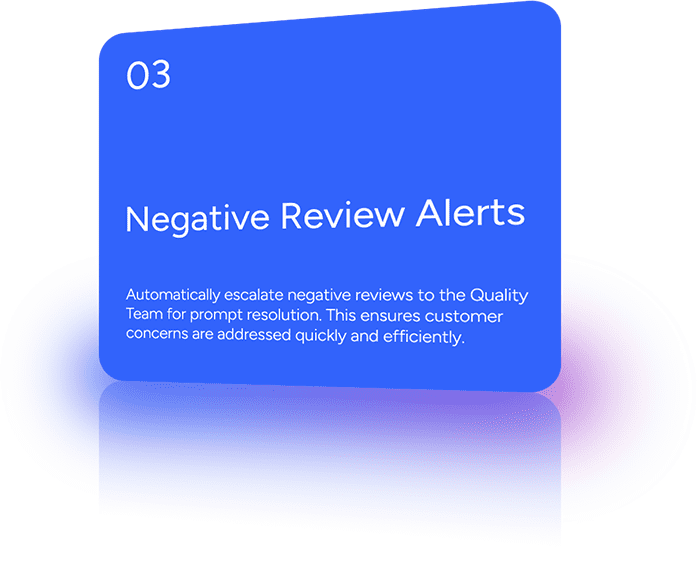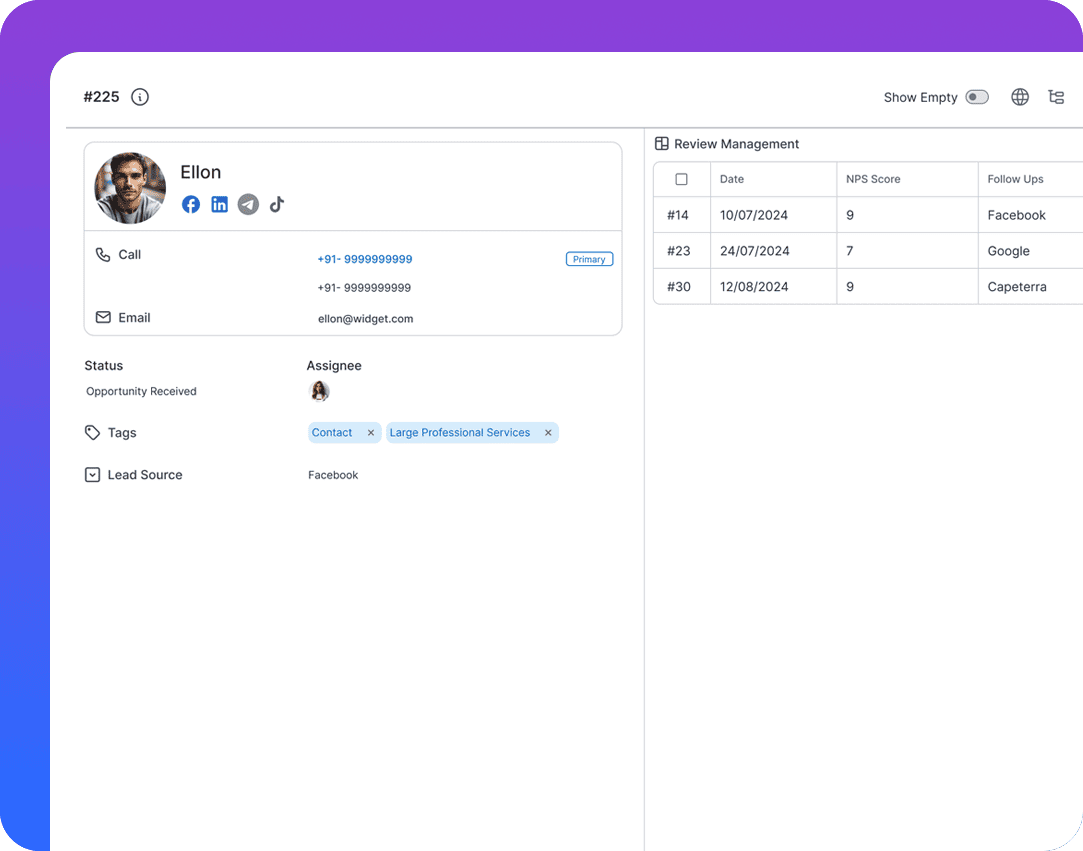Streamline Customer Reviews
Automate Customer Review Generation
Effortlessly gauge client satisfaction, personalize interactions, and scale review generation seamlessly on Google and beyond.

Automate Customer Review Generation
Effortlessly gauge client satisfaction, personalize interactions, and scale review generation seamlessly on Google and beyond.


Automatically send review forms to customers post-interaction. Capture reviews based on their inputs directly in Pronnel.

Send customers review links for third-party platforms. Capture reviews and trigger actions based on feedback.

Escalate negative reviews for resolution. Use positive reviews for upselling opportunities and improving customer relations.

Boost customer satisfaction by capturing real-time feedback and addressing concerns promptly.
Leverage positive reviews for promotional purposes and improve brand reputation effortlessly.
Identify upselling opportunities based on positive reviews, enhancing revenue generation strategies.










With increased focus on increasing Customer LTV's, teh Customer Success function has moved from being a support organ to being the frontline of Customer Relationships.Empower your Customer Service Team with Pronnel's Customer Service templates.
The Marketing team's work never ends. Whether creating content, publishing online, organizing events, creating collateral, conducting Market Research, running Ads. Even in the most conservative organizations, a Marketing resource needs to complete between 5 and 10 individual tasks daily.
Juggling calendars for appointments can be painful. Even more painful can be corrdinating meetings at a convenient time with clients. It is such a pain, that many organizations pay as much as USD 10 p.m. per user for tools like Calendly.
Pronnel Customer streamlines Sales Administration by reducing the effort needed to oversee large sales teams, making it easy to manage tasks, track performance, and generate insightful reports.
Professional services companies, like tax accounting and business services, need effective complaint management to maintain client trust.
Software product companies require robust complaint management to handle high volumes of customer issues.
IT service companies need efficient complaint management to maintain service quality and client relationships.
Monitoring customer reviews is critical for any organization. With the cost of acquiring new customers driven up by competition, monitoring customer reviews can provide an early warning if something is not working. According to a study (Source: Customer 2020, by Walker Information & Customer Think), Customer Experience is expected to overtake Price and Product as a key brand differentiator. Further evidence is provided by this Harvard Business Review article (Research: The Pros and Cons of Soliciting Customer Reviews by Leif Brandes, David Godes, and Dina Mayzlin, Mar 2023), where ninety-eight percent of customers read reviews before they shop, making it one of the most important sources of information about products and services; for 2021, online reviews were predicted to affect $3.8 trillion revenues worldwide.Ignoring customer reviews will leave you blindsided. With customer sentiment being a crucial factor in purchasing decisions, monitoring reviews allows organizations to stay proactive in addressing customer concerns, improving products or services, and maintaining a positive brand reputation.
The simple answer is not just the Customer Service or Customer Experience teams. If a slogan needs to be crafted, it would read something like "Customer Experience is too important to leave to Customer Service. It's everyone's business."
Empirical evidence shows that Customer Experience (CX) is a value driver for a company's top and bottom lines. Academic literature backs this up. In "Customer Experience Is Everyone’s Responsibility" (Rebecca Hinds and Sarang Gupta, April 2023, Harvard Business Review), this theme is explored in depth.
To put it simply, how a company embraces customer experience differentiates the bad from the great:
Bad Companies: View customer service as a necessary expense and minimal compliance requirement.
Average Companies: Invest in Customer Service teams to handle customer experience issues reactively.
Good Companies: Invest in Customer Service, analyze trends, and proactively address potential issues.
The Best Companies: Make customer experience a core cultural value, actively communicate CSAT scores and initiatives, build cross-functional teams, and ensure all employees regularly engage with customers or handle customer service calls.
#ProTip: Few companies are as obsessed with CX as Amazon. Interested readers should check out "Invent and Wander: The Collected Writings of Jeff Bezos" by Walter Isaacson and Jeff Bezos. This semi-biographical account of Bezos' reflections on his core principles and philosophy is a gold mine for CX leaders.
In summary, customer experience is everyone's responsibility.
There are multiple methods for measuring customer satisfaction, and it would be an injustice to attempt to explain them all. Therefore, we shall discuss three of the most popular ones:
Net Promoter Score (NPS)
Methodology: NPS measures customer loyalty by asking customers how likely they are to recommend a product or service to others on a scale of 0 to 10. Based on their responses, customers are categorized into Promoters (9-10), Passives (7-8), and Detractors (0-6). The NPS is calculated by subtracting the percentage of Detractors from the percentage of Promoters.
History: Introduced by Fred Reichheld, while working as a partner in Bain & Co., in 2003 through a Harvard Business Review article, NPS has become a widely adopted metric for gauging customer loyalty.
Pros: Simple to implement and understand, provides a clear indicator of customer loyalty and potential for growth, and allows for benchmarking across industries.
Cons: Doesn't provide specific insights into why customers are Promoters or Detractors, can be influenced by recent experiences rather than overall satisfaction.
Major Industries Using It: Technology, retail, telecommunications, financial services.
CSAT (Customer Satisfaction) Scores
Methodology: CSAT scores measure customer satisfaction with a specific interaction or overall experience. Customers are asked to rate their satisfaction on a scale (typically 1-5 or 1-7). The CSAT score is the percentage of satisfied customers (those who rated 4 or 5 on a 5-point scale).
History: CSAT has been a staple metric in customer satisfaction surveys for decades, providing direct feedback on specific aspects of customer experience.
Pros: Easy to understand and implement, provides immediate feedback on specific interactions, and can be used to measure satisfaction across various touchpoints.
Cons: Can be limited in scope, doesn't necessarily indicate long-term loyalty, and may be influenced by individual biases.
Major Industries Using It: Hospitality, healthcare, e-commerce, customer service.
CES (Customer Effort Score)
Methodology: CES measures the ease of customer interactions with a company. Customers are asked to rate how much effort they had to exert to get an issue resolved or to use a product/service on a scale of 1 to 5 or 1 to 7.
History: Introduced by the Corporate Executive Board (now Gartner) in 2010, CES was designed to predict customer loyalty by focusing on the effort required from customers.
Pros: Strong predictor of customer loyalty, highlights areas where processes can be simplified, and helps reduce customer friction.
Cons: May not capture the full scope of customer satisfaction, and can be misinterpreted if not used alongside other metrics.Major Industries Using It: Customer service, telecommunications, utilities, financial services.
At Pronnel, we recommend using NPS due to its simplicity and effectiveness in measuring customer loyalty. Our Review Boards come pre-built to gather reviews using the NPS methodology, ensuring you can start capturing valuable insights right away.
Of course. At Pronnel, we are all about helping you manage your business successfully. While we strongly recommend using the Net Promoter Score (NPS) methodology, we are completely flexible in enabling other methodologies of your choice. Whether it's CSAT, CES, or any other specific method, we can accommodate your needs.
Feel free to drop us an email at sales@pronnel.com, and our Sales team will promptly get back to you to understand your requirements and provide a timeline and estimate for the customization.
Using Net Promoter Score (NPS) to measure customer satisfaction offers several advantages over Customer Satisfaction (CSAT) and Customer Effort Score (CES):
Holistic Perspective: NPS provides a broader view of customer satisfaction by focusing on loyalty and advocacy, rather than just satisfaction with individual transactions (CSAT) or effort expended (CES).
Predictive Power: Research suggests that NPS is a strong predictor of customer behavior, such as repurchasing and recommending products/services, making it a valuable metric for assessing long-term business success.
Actionable Insights: NPS identifies promoters (loyal customers) and detractors (unhappy customers), enabling targeted action to improve customer experience and drive business growth.
Benchmarking: NPS allows for benchmarking against industry standards and competitors, providing context for performance evaluation and strategic decision-making.
Alignment with Business Outcomes: Studies have shown a positive correlation between NPS and financial performance, indicating that firms with higher NPS scores tend to achieve greater profitability and sustainable growth.
For example, a study published in the Journal of Marketing Research ("The Economics of Net Promoter Score" by Sunil Gupta and Carl F. Mela, 2013) found that companies with higher NPS scores experienced faster revenue growth compared to their competitors. Similarly, research published in the Harvard Business Review ("The One Number You Need to Grow" by Fred Reichheld, 2003) demonstrated a strong link between NPS and customer loyalty, customer retention, and business growth.
By leveraging NPS to measure customer satisfaction, firms can gain actionable insights, drive customer-centric strategies, and ultimately achieve sustainable competitive advantage in the marketplace.
The NPS survey sent by the CRM typically includes just one primary question: "How likely are you to recommend our product/service to a friend or colleague?" This question is usually rated on a scale from 0 to 10. Additionally, the survey may include an optional follow-up question asking respondents to explain the reason for their rating, providing more context and actionable insights.
Normal screening and background information questions are not added so that the respondent does not get irritated by an overtly long form. Typically, most consumers will think, "{ am your customer, you have my details. Why are you bothering me to fill all of them." Instead, Pronnel Customers smart technology can match the client to the response and will map the review into the Customer Contact card also.
Of course, if you want, you can ask more questions, but we would urge you to consider the fact that lengthier surveys have higher dropout rates.
The standard reviews available are:
1. Fiscal year-wise NPS Scores
2. Fiscal year-wise NPS Score for Regular Reviews
3. Fistal year-wise NPS score for Post-Complaint Resolution Reviews.
Focusing on generating reviews on external sites is essential for several reasons:
Credibility and Trust: Reviews on third-party sites are perceived as more trustworthy and unbiased by potential customers. This enhances your credibility and can significantly influence purchasing decisions.
SEO Benefits: Reviews on external sites improve your search engine rankings. Search engines consider these reviews as signals of authority and relevance, helping your business appear higher in search results.
Wider Reach: External review sites often have a broad audience, increasing your brand's visibility. This can attract new customers who may not have discovered your business otherwise.
Competitive Advantage: A strong presence on review sites can set you apart from competitors. Positive reviews highlight your strengths and can be a deciding factor for potential customers comparing similar options.
Important Review Sites for Different Industries:
Retail and E-commerce
- Amazon
- Google Reviews
- Yelp
Hospitality and Travel
- TripAdvisor
- Booking.com
- Expedia
Restaurants and Food Services
- Yelp
- Zomato
- OpenTable
Healthcare
- Healthgrades
- Zocdoc
- RateMDs
Real Estate
- Zillow
- Realtor.com
- Trulia
Automotive
- Google Reviews
- Edmunds
- Cars.com
Software and Technology
- G2
- Capterra
- Trustpilot
Professional Services
- Avvo (legal services)
- Angie’s List (home services)
- Clutch (B2B services)
Focusing on generating reviews on these platforms can significantly boost your business's online presence, credibility, and customer acquisition. Disclaimer: These are global sites; it’s always beneficial to consider what's popular in your country or geographical region.
Pronnel's Review Management solution includes an automated escalation routine for negative reviews. When a negative review is detected, the system automatically initiates a quality control (QC) escalation process, ensuring that these reviews are promptly investigated and addressed. This helps in resolving customer issues quickly and maintaining a positive brand image.
Yes, Pronnel's Review Management solution integrates seamlessly with major external review platforms like Google, Capterra, and Facebook. The system can automate the process of requesting reviews from satisfied customers and direct them to these platforms. This helps in building a strong online presence and enhancing the credibility of your brand.
The 360 Customer View feature provides a comprehensive insight into a customer's history and interactions. It maps reviews to customer contact and organization cards within the CRM, allowing for detailed analysis of customer sentiment over time. This feature enables businesses to understand customer behavior, track changes in satisfaction, and tailor their strategies accordingly.
The Customer Centricity Dashboard offers a consolidated view of customer satisfaction metrics, including NPS scores, review trends, and engagement data. This dashboard allows businesses to visualize customer feedback trends over time, identify areas for improvement, and make data-driven decisions to enhance customer experience. It also helps in setting and tracking performance targets, ensuring a customer-focused approach across the organization.

Business Development Head in United Arab Emirates
Love the user interface and the straightforward navigation. Tailoring the CRM was effortless, thanks to the amazing customization options.

Director/ Partner in United Arab Emirates
This application can do anything and everything based on your requirements, any modifications can be done based on your requirements.

Executive Assistant in India
Ease of use and efficiency with which I could see which all tasks have been done and what is yet to do